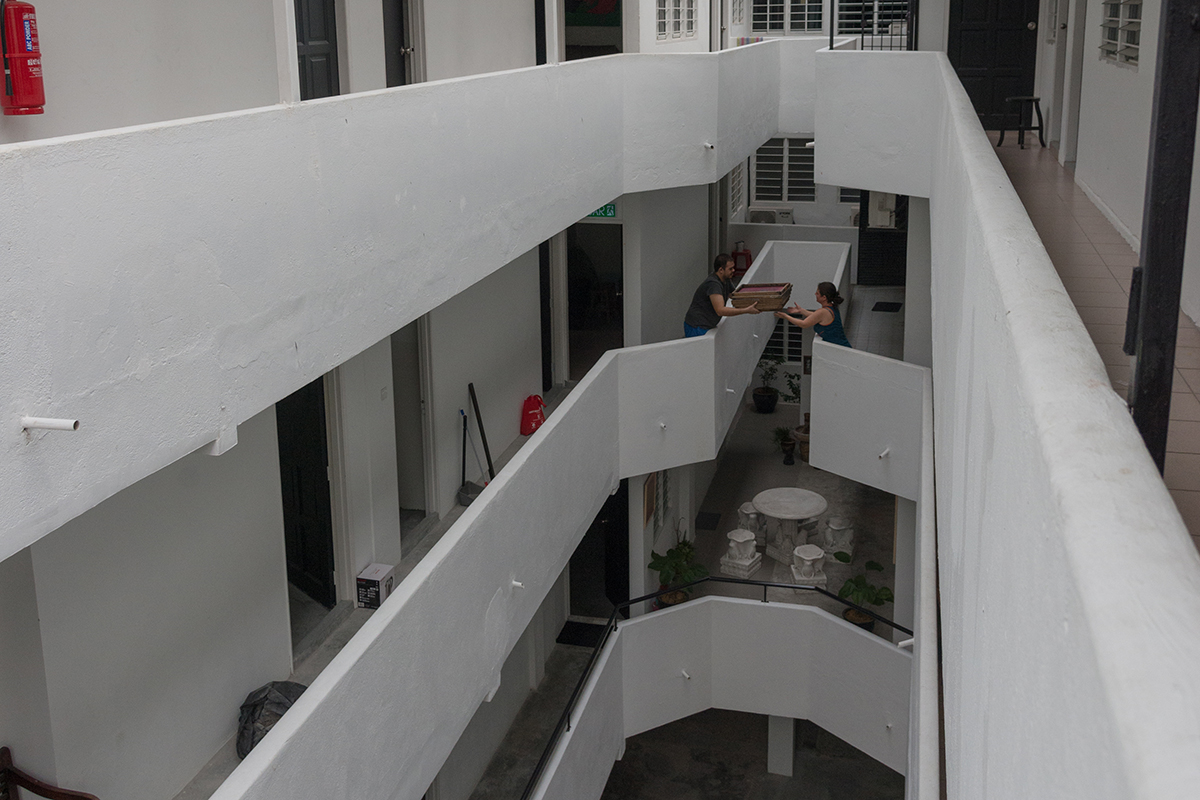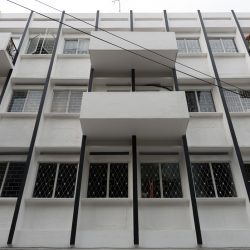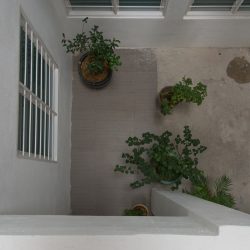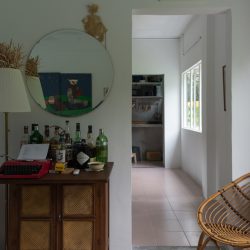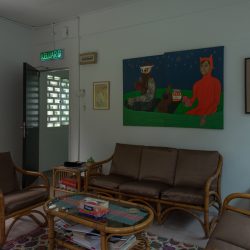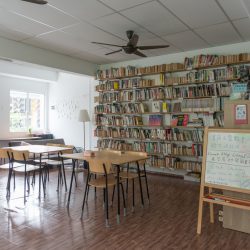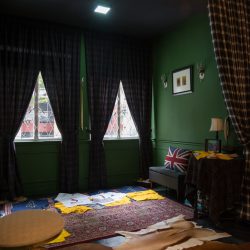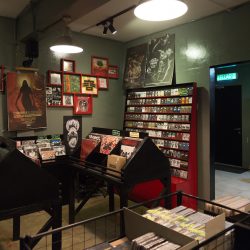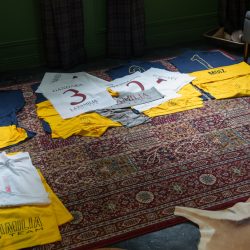THIS SIMPLE BUILDING IN KUALA LUMPUR OFFERS THE MOST WANTED HELP TO ANY PEOPLE OUT THERE
The Zhongshan Building is an old architectural structure in Kuala Lumpur. Having lived through the turnings of time, its ground floor courtyard once housed a fresh market selling local produce from fruits to vegetables while the upper floor was occupied by twenty living units whose residents were foreign laborers working in Malaysia’s capital city. With Kampung Attap being a neighborhood that is located near KL’s city center, several offers have been made to buy and turn the building into an entertainment complex. But to Rob Tan who was born and raised in this building, the structure is and could be more than just a low-budget hotel. Such belief led to the birth of the city’s latest arts and research community. The empty rooms are rented out to the people from the art and design communities (primarily the folks of Design Union) with the condition being that they can do pretty much anything as long as it doesn’t affect the building’s structure. “Kuala Lumpur’s design community isn’t really that big so once the idea spread, we had a lot of people contacting us. We all know that the community exists but what most designers are looking for is simply just a place.”
From our conversation with Tan, we learned that Kuala Lumpur once had a space of a similar nature known as The Annexe located in Sentral Market, but it was later closed permanently. Initially, the goal Tan had for the Zhongshan Building was for it to be a space that would be able to support members of the design community in the same way and to the same extent that Cockpit Arts had done for the design community in London. “Most galleries in Kuala Lumpur are rather commercially driven so we started to talk with the design practitioners in Kuala Lumpur and came to the conclusion that what they wanted was a space where they could live and work together.”
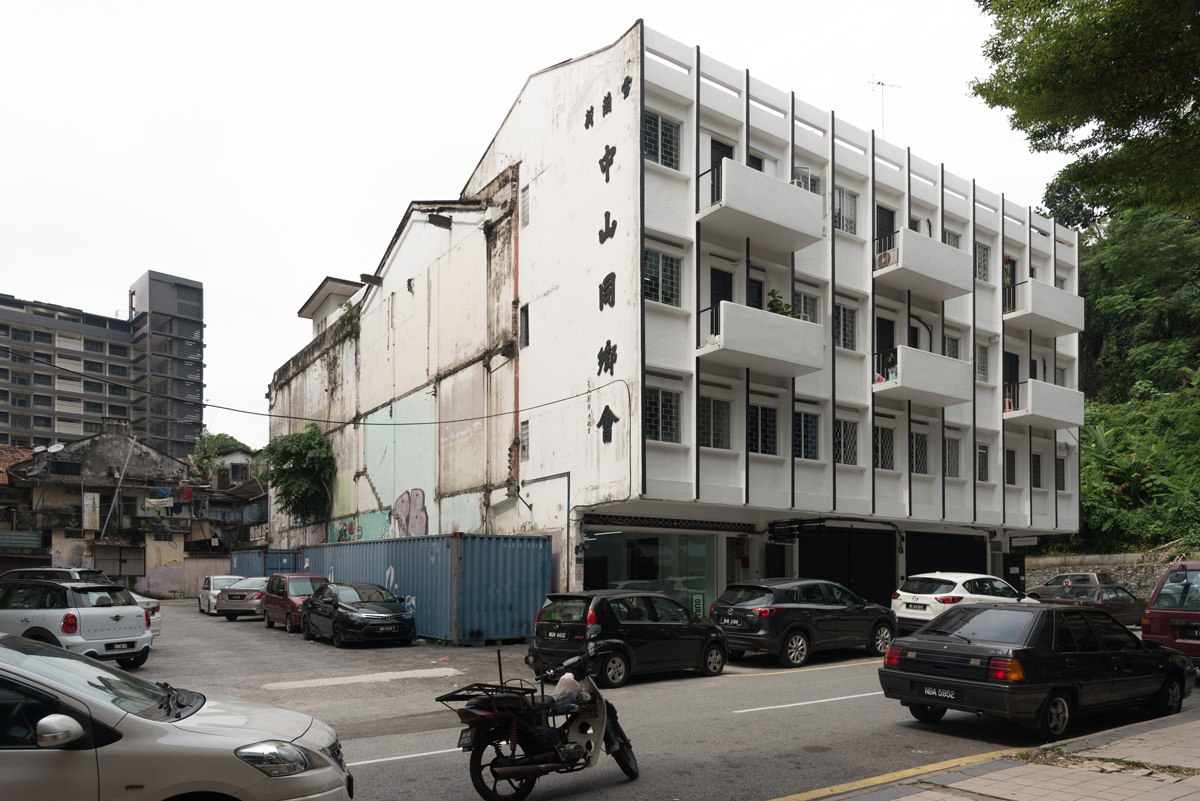
Nevertheless, while what Cockpit Arts offers is a largescale organization that welcomes applicants from different fields of design to work within the same physical space, with services encompassing design consultancy for those who want to start their own brands and assistance with issues like the formation of a business model, financial management and advice with legal protocols as well as sales promotional programs such as the creation of a website where buyers can search and contact makers directly. The main objective is to help support designers and encourage them to pursue and develop their design careers. For the Zhongshan Building (in the beginning), Tan doesn’t position the space to fall in line with what Cockpit Arts is doing. What he aspires to do is create a space for the people in the design/art communities with the rather straightforward benefit being the financial aid offered through the building’s comparatively low rental rate.
“I don’t have to burden myself with the rent because the building is already mine.” What’s cool about this community is the diversity of the tenants that range from members of the design crowd to professionals from other industries. With the current number of tenants reaching almost 20 different groups, their interests vary and practices ramify into 10 different activities ranging from a screening room, galleries, print studio, library, bookshop, café, tailor boutique and graphic studios to a space for an artist-in-residence program, and the most surprising member of the community, a legal office. Another interesting thing about the Zhongshan Building is Tan’s adaptation of residential units into the semi-public space, which has a great deal of influence on the spatial experience that the place has to offer. For instance, if one were to visit a punk rock records shop named Tadang Record Store, he or she would have to walk past a lecture room run by Malaysia Design Archive and through the bookshop, Tintabudi Bookstore in order to reach the building’s communal walkway and finally arrive at the record parlor. If you’re planning to go to the hang out space called Living Room Collective on the upper floor, you are forced to walk past at least one of the tenants’ studios and on the very same floor, you will come across Rumah Attap Library & Collective, a non-profit library that has put together an impressive collection of political science publications that welcomes everyone to spend their time in their reading room. The floor plan of the Zhongshan Building is pretty much like a maze and the doors of some of the rooms are standard-looking doors that don’t even indicate what is waiting behind. Visitors are handed an element of surprise and excitement when knocking on these doors and finding out what kind of experience they are about to encounter. The walkways are designed to force people to walk through one room in order to get to another, and such manipulation of the building’s circulation brings about a positive final result in the sense that it helps distribute visitors to access every unit in the Zhongshan Building and ultimately stimulates conversations between the hosts and visitors for it’s very unlikely that one will find their desired destination without speaking and asking for direction from the tenants.
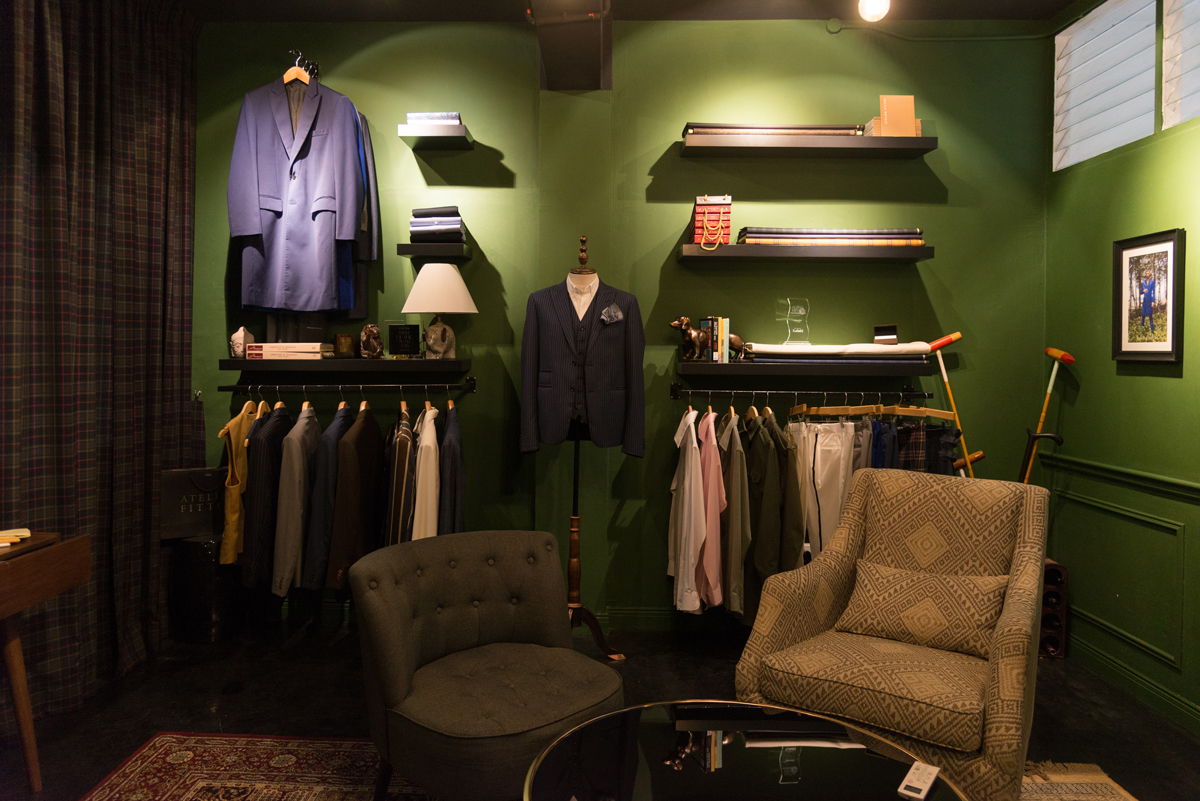
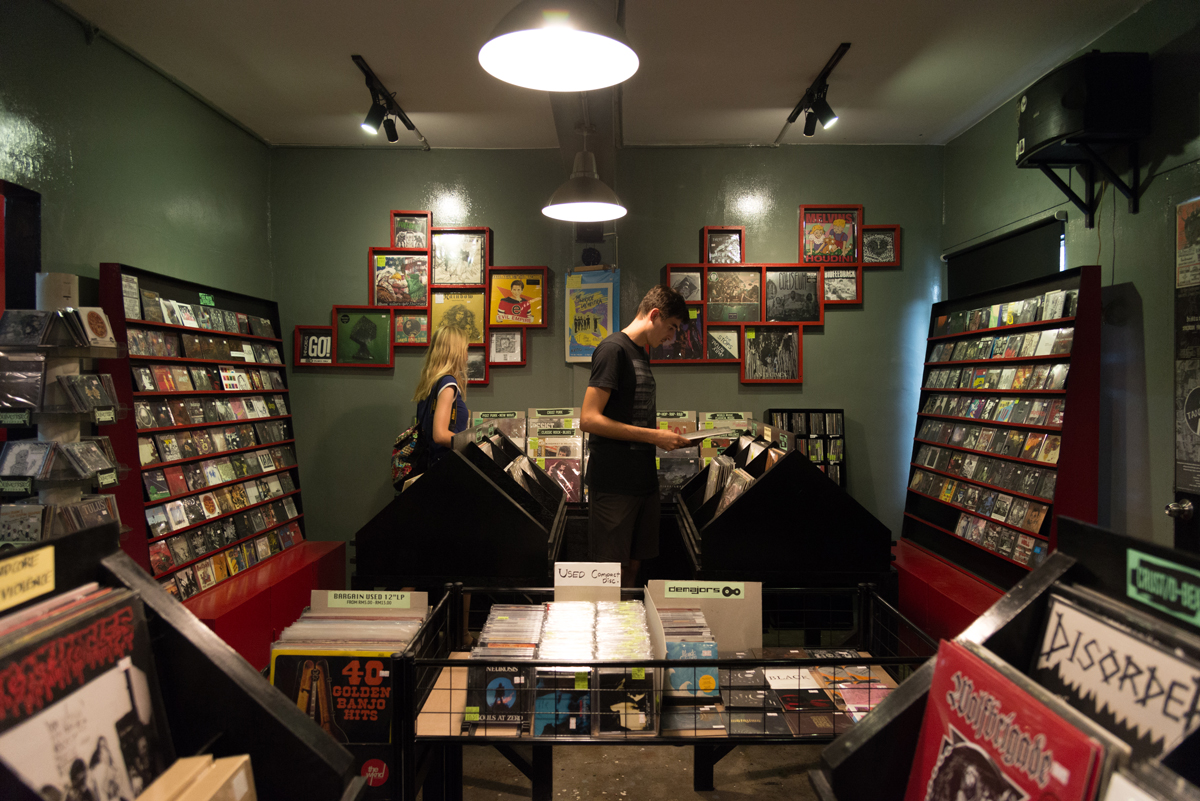
The Zhongshan Building was officially opened in July of 2017 although some of the units had begun their activities prior to the opening day. art4d was present at the talk held by Malaysia Design Archive under the topic Artistic Responses to Recent Street Protests in Kuala Lumpur. We will not be discussing the content of the talk here, but we can tell you that it essentially featured the transitional time before Malaysia achieved independence from Great Britain under the leadership of the UMNO Party. What we found to be very impressive is that despite the scheduled time of the talk being 20.00 (which is fairly late for an academic lecture of such an intense subject matter), almost 30 interested individuals crammed into that small room to listen to the speakers. On the very same night, in another room located in the same building, a screening session of fono’s films was being hosted.
In the near future, the Zhongshan Building will welcome a Singapore-national gift shop called Naiise, which will take over a space on the ground floor next to OUR ArtProjects’ gallery. Tan told art4d that the arrival of Naiise should be another gimmick that is expected to attract a new and somewhat wider group of people to the community. But from our observation, the factor that brings visitors to the Zhongshan Building is more accurately the content that the space is creating. It remains to be seen whether the tenants will be replaced in the future, and who will be the new additions because at the end of the day, the change of tenants should be beneficial for the space in the long run, especially when considering the new subject matter and activities they will bring to the building’s spatial program.
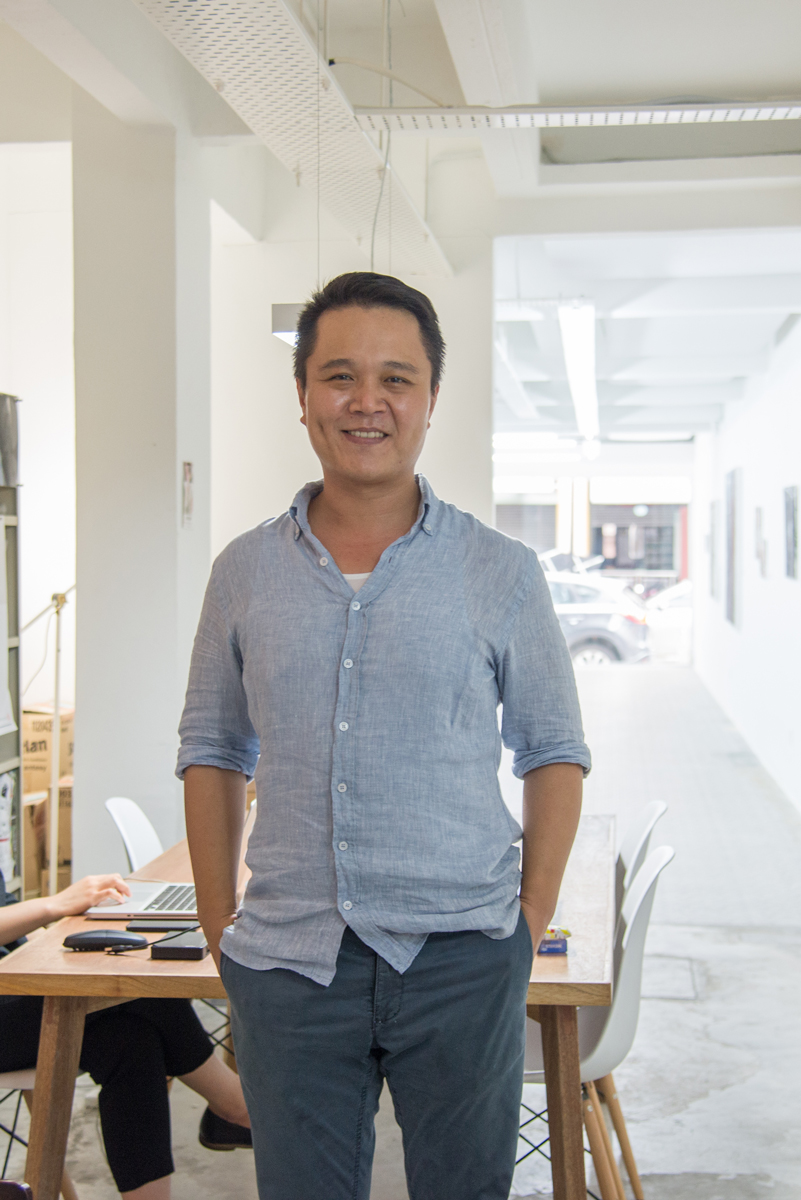
The Zhongshan Building เป็นอาคารเก่าที่ผ่านการใช้งานมาหลายยุคหลายสมัย คอร์ตยาร์ดชั้นล่างเคยเป็นตลาดสด ขายผักผลไม้มาก่อน ส่วนชั้นบนที่เป็นห้องพักประมาณ 20 ห้องเคยถูกใช้เป็นที่พักของแรงงานต่างชาติที่มาทำงานในกัวลาลัมเปอร์ในช่วงเวลาหนึ่ง หลังจากนั้น ด้วยความที่ย่าน Kampung Attap อยู่ใกล้กับศูนย์กลางเมืองกัวลาลัมเปอร์ จึงมีหลายๆ คนยื่นข้อเสนอขอซื้ออาคารนี้ไปทำาเป็นสถานเริงรมย์ แต่สำหรับ Rob Tan ที่เกิดและเติบโตในอาคารหลังนี้ เขามองว่าอาคารนี้สามารถเป็นอย่างอื่นได้มากกว่าแค่โรงแรมราคาถูก เขาจึงเปลี่ยนมันมาเป็น arts and research community โดยเปิดห้องว่างเหล่านั้นให้กลุ่มคนทำงานศิลปะ / ออกแบบ (โดยเฉพาะกลุ่ม DesignUnion) เช่าในเงื่อนไขที่ว่าทำอะไรก็ได้ที่ไม่ส่งผลกระทบต่อโครงสร้างอาคาร “วงการดีไซน์ในกัวลาลัมเปอร์ไม่ได้ใหญ่มาก พอไอเดียกระจายออกไปก็มีคนติดต่อเข้ามาทันที คือเรารู้ว่า community มันมีอยู่แล้ว เพียงแต่นักออกแบบส่วนใหญ่ต้องการ place เท่านั้นเอง”
เท่าที่ Tan บอกกับเรา ในกัวลาลัมเปอร์เคยมีพื้นที่ลักษณะคล้ายๆ กันนี้ชื่อว่า The Annexe ที่ตั้งอยู่ในย่าน Sentral Market แต่ปิดตัวไปแล้ว ส่วนเป้าหมายกว้างๆ ที่ Tan ร่างไว้ตอนนี้ก็คือ ถ้าเป็นไปได้เขาอยากทำให้ The Zhongshan Building สามารถสนับสนุนดีไซเนอร์ได้มากเท่ากับที่ Cockpits Arts สนับสนุน community ดีไซเนอร์ในลอนดอน “แกลเลอรี่ส่วนมากในกัวลาลัมเปอร์ค่อนข้างคอมเมอร์เชี่ยล ตอนนั้นเราก็เลยเริ่มคุยกับกลุ่มดีไซเนอร์ในกัวลาลัมเปอร์ และได้ข้อสรุปว่าพวกเขาอยากได้พื้นที่สำหรับอาศัยและทำงานอยู่ร่วมกัน”
อย่างไรก็ตาม ในขณะที่ Cockpit Arts เป็นองค์กรขนาดใหญ่ที่รับสมัครคนทำงานดีไซน์หลายๆ สายงานให้มาทำางานในพื้นที่เดียวกัน โดยมีบริการให้คำาปรึกษาสำหรับผู้ที่ต้องการเปิดแบรนด์ของตัวเอง ทั้งในด้านโมเดลธุรกิจ การบริหารจัดการด้านการเงิน ด้านกฎหมาย รวมถึงโปรแกรมการส่งเสริมการขาย อย่างเช่นการทำเว็บไซต์ที่ผู้ซื้อสามารถเสิร์ชหาชื่อ และติดต่อเมคเกอร์ได้โดยตรง โดยมีเป้าหมายหลักๆ คือการประคับประคองให้ดีไซเนอร์สามารถต่อยอดการทำงานด้านนี้ต่อไปได้ แต่สำหรับ The Zhongshan Building นั้น (ในช่วงเริ่มต้น) Tan ไม่ได้วางบทบาทตัวเองเป็นพี่เลี้ยงดีไซเนอร์แบบที่ Coctpit Arts ทำ แต่สิ่งที่ Tan ทำคือ การสร้างพื้นที่ของ community ด้านการออกแบบ / ศิลปะขึ้นมา และให้การสนับสนุนด้วยวิธีการที่ตรงไปตรงมามากๆ นั่นคือการเก็บค่าเช่าที่ราคาไม่สูงนัก
“ผมไม่มีต้นทุนด้านค่าเช่าสถานที่ เพราะอาคารนี้มันเป็นของผมอยู่แล้ว” ความเจ๋งของ community แห่งนี้คือความหลากหลายของผู้เช่าที่ไม่ได้มีแค่คนทำงานด้านดีไซน์ แต่ยังมีคนวงการอื่นๆ มาเช่าพื้นที่นี้ด้วย ตอนนี้กลุ่มผู้เช่ามีถึงเกือบ 20 กลุ่ม ซึ่งพอจำแนกออกมาแล้วจะสามารถแบ่งกิจกรรมได้ถึง 10 แบบ ตั้งแต่ ห้องฉายหนัง แกลเลอรี่ พริ้นท์สตูดิโอ ห้องสมุด ร้านหนังสือ คาเฟ่ ร้านตัดสูท กราฟิกสตูดิโอ พื้นที่โครงการศิลปินในพำนัก และที่แปลกที่สุด คงจะเป็นสำนักงานทนายความ ส่วนความน่าสนใจอีกอย่างก็คือ การปรับห้องสำหรับอยู่อาศัยมาเป็นพื้นที่กึ่งสาธารณะของ Tan ซึ่งส่งผลต่อประสบการณ์การเดินเที่ยว The Zhongshan Building เป็นอย่างมาก เพราะสมมติว่าถ้าเราอยากจะไปร้านแผ่นเสียงเพลงพังค์ร็อคชื่อ Tadang Record Store เราจะต้องเดินผ่านห้องจัดเล็คเชอร์ของ Malaysia Design Archive ทะลุร้านหนังสือ Tintabudi Bookstore เพื่อออกไปยังทางเดินกลางของตึก ก่อนถึงจะไปถึงร้านแผ่นเสียงที่ว่า หรือถ้าจะไปพื้นที่แฮงค์เอาท์ชั้นบนที่ชื่อ Living Room ก็จำเป็นต้องเดินผ่านสตูดิโอของใครสักคนก่อนอย่างน้อย 1 ห้อง ซึ่งชั้นเดียวกันนั้นก็ยังมี Rumah Attap Library & Collective ห้องสมุดไม่แสวงหาผลกำไรที่รวบรวมหนังสือด้านรัฐศาสตร์ให้แวะเข้าไปนั่งพักอ่านหนังสืออีกด้วย ผังอาคาร The Zhongshan Building เหมือนเขาวงกต ประตูของห้องก็เป็นประตูห้องพักมาตรฐานที่บางห้องไม่มีป้ายติดว่าในนั้นเป็นอะไร ปล่อยให้เราลองเคาะและลุ้นเอาเองว่าเปิดเข้าไปแล้วในนั้นจะเป็นอะไร นอกจากความเซอร์ไพร์สจากการเคาะประตูห้อง ทางเดินภายในอาคารที่บังคับให้คนต้องเดินผ่านห้องหนึ่งเพื่อไปยังอีกห้อง การออกแบบทางสัญจรภายใน The Zhongshan Building เช่นนี้ก็ยังส่งผลดีในแง่ที่ว่า มันเป็นการกระจายคนให้เข้าถึงในทุกๆ ยูนิตของอาคาร รวมทั้งกระตุ้นให้เกิดบทสนทนาระหว่างเจ้าบ้านและผู้มาเยือน เพราะอย่างน้อยคือถ้าไม่ถามทางคงไปไม่ถึงห้องที่อยากจะไปแน่ๆ
The Zhongshan Building เพิ่งเปิดตัวอย่างเป็นทางการเมื่อปลายเดือนกรกฎาคมที่ผ่านมา แต่ก่อนหน้านั้นก็มีบางห้องเริ่มจัดกิจกรรมกันก่อนแล้ว art4d ได้ไปร่วมฟังงานเสวนาที่ Malaysia Design Archive ในหัวข้อ Artistic Responses to Recent Street Protests in Kuala Lumpur ในพื้นที่ตรงนี้ เราคงไม่พูดถึงเนื้อหาของงานเสวนาที่พาเราย้อนกลับไปถึงช่วงหัวเลี้ยวต่อก่อนที่มาเลเซียจะได้รับเอกราชจากอังกฤษภายใต้การนำของพรรคอัมโน (UMNO) แต่ภาพที่เราเห็นคือ ถึงแม้จะเริ่มทอล์คในเวลา 20.00 น. (ที่ออกจะเป็นเวลาที่ดึกไปเสียหน่อยสำหรับงานวิชาการหนักๆ ) แต่ก็ยังมีผู้สนใจเกือบ 30 คน มานั่งเบียดกันอยู่ในห้องเล็กๆ เพื่อฟังบรรยาย และในคืนเดียวกันนั้น ก็ยังมีกิจกรรมฉายหนังของ fono ห้องฉายหนังที่อยู่ในอาคารเดียวกันด้วย
ในอนาคตอันใกล้ The Zhongshan Building จะมีร้านกิ๊ฟช็อปชื่อ Naiise จากสิงค์โปร์มาเปิดชั้นล่างข้างๆ แกลเลอรี่ของ OUR ArtProjects ที่ Tan บอกกับ art4d ว่าเป็นกิมมิคที่น่าจะช่วยดึงกลุ่มคนอีกกลุ่มให้แวะเวียนมายัง community แห่งนี้ได้อีกเป็นจำนวนไม่น้อย แต่เท่าที่สังเกต ปัจจัยที่ดึงคนให้มาที่ The Zhongshan Building น่าจะเป็นที่เนื้อหาที่สถานที่แห่งนี้นำเสนอออกมามากกว่า ก็ต้องรอดูต่อไปว่าในระยะยาวจะเกิดการเปลี่ยนมือผู้เช่าห้องหรือไม่ ถ้าคนเก่าออกแล้วใครจะมาใหม่ เราคิดว่าการเปลี่ยนมือผู้เช่าห้องน่าจะเป็นเรื่องดี เพราะมันไม่ต่างอะไรกับการเติมเนื้อหาใหม่ๆ ใส่ให้กับอาคารอยู่ตลอดเวลา
TEXT&PHOTO : NAPAT CHARITBUTRA
facebook.com/thezhongshanbuilding

